 MaraSimba18.jpg |
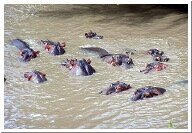 MasaiMara180.jpg |
 MasaiMara011.jpg |
| Every morning and evening our open top van would take us for game viewing throughout the preserves. We could get up-close and personal with the animals. | Hippos spend most of their day in the water in a tight knit social group. At dark they come out and forage for food. | Zebras were found in all of the preserves we visited. We learned that each has its own distinctive markings much like fingerprints. |
 MasaiMara018.jpg |
 MasaiMara036.jpg |
 MasaiMara040.jpg |
| The wildebeest is a funny looking animal much like a skinny American bison. They are used as a food source in Kenya. | We ran across a mother hyena feeding her baby. She and the young one had just come out of a den in grassy, unprotected area. | Giraffes are strange, elegant animals found throughout Kenya. With their long legs they are very fast runners. |
 MasaiMara058.jpg |
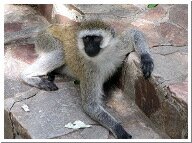 MasaiMara194.jpg |
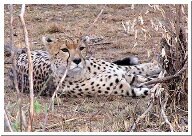 MasaiMara222.jpg |
| This is a male ostrich. M uch like many American birds the male has the most beautiful colors. | Monkeys are everywhere there are tourists but cause very little trouble. This fellow greeted us at Mara Simba Lodge. | On a game viewing trip you may drive several hours without seeing animals. Then you run across a beautiful specimen like this cheetah. |
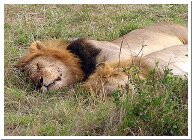 MasaiMara384.jpg |
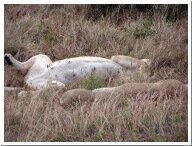 MasaiMara245.jpg |
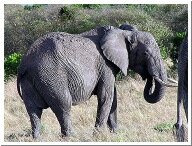 MasaiMara325.jpg |
| Like all cats, lions spend a big part of their day sleeping. They sleep soundly, not at all disturbed by the dozens of tourist vehicles nearby. | Not all of the big cats are graceful when they sleep. This lioness may even have been snoring. | Elephants are found throughout Kenya mostly traveling in herds. They don't seem to be at all concerned about visitors but drivers keep a close eye on them. |
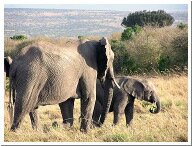 MasaiMara327.jpg |
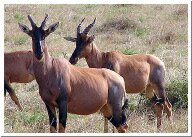 MasaiMara361.jpg |
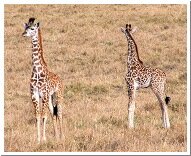 MasaiMara405.jpg |
| The African elephant is the largest of all land animals. Many can be seen with young. The gestation period for elephants is a long one of almost two years. | The topi antelope is easy distinquished by the dark patches on their hind quarters. | This was a a touching scene. These two young giraffes had either been separated from the herd or abandoned. On their own they will probably not live through the night because they are easy prey for predators. You could almost sense their fear. |
 MasaiMara437.jpg |
 MasaiMara456.jpg |
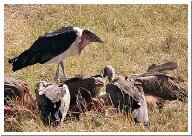 MasaiMara464.jpg |
| This photo of a mother cheetah nursing her five cubs is one of my favorites. Neither the mother nor the cubs seem at all fearful of the tourists swarming around them. | Most the animals, such as this lioness, seem unperturbed by the many vans of tourist who flock around whenever they are spotted. They apparently know that they are in a protected preserve and have nothing to fear. | The vultures and another strange African bird can be seen cleaning up what is left of an animal's last meal. |
 Masai01.jpg |
 Masai11.jpg |
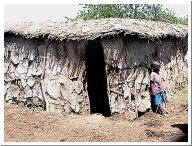 MasaiVillage033.jpg |
| The Masai tribe live in southern Kenya and North Tanzania. They are very tall and slim in part because their diet is made up milk and blood plus some meat. They are known for their jumping ability. | At the Masai village not only the warriors but also the women perform a traditional welcoming song and dance. | Masai villages are circular for protection. The houses are made of dried cow dung and mud. The ground throughout the village is covered with dung from the tribe's cattle. |
 MasaiVillage092.jpg |
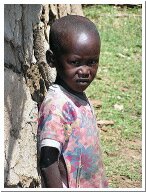 MasaiVillage032.jpg |
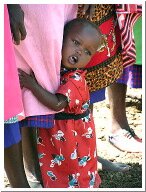 MasaiVillage037.jpg |
| Like children everywhere, Masai are curious about strangers but also a little apprehensive about getting too involved. | Tourists are looked at with a wary and perhaps questioning eye when so many white people descend upon the village. | The Masai are noted for their colorful clothing. Some of that can be seen in this photo of a little girl clinging to her mother for assurance during the tourist invasion. |
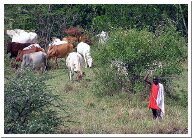 MasaiMara345.jpg |
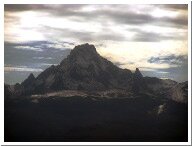 MtKenya01.jpg |
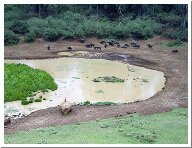 MtLodge10.jpg |
| The Masai are herders and stay with their herds as they graze upon the open range. This herdsman spied the camera and gave a friendly wave. | Mt. Kenya is the second highest mountain in Africa, next to Mt. Kilanmajaro. This view was taken on a small plane flight from Nairobi to Samburu. | At the Mountain Lodge animals come to people rather than people trying to find them. The hotel is built over a large watering hole where animals come day and night to drink and graze. Each room in the hotel has a balcony overlooking the watering hole. |
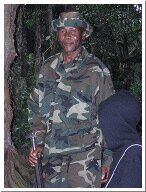 MtLodge70.jpg |
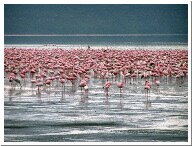 Nakuru47.jpg |
 Nakuru46.jpg |
| Two armed guards accompany groups taking hikes in the woods near the Mountain Lodge. That's because a variety of animals tramp through the woods to get to the watering hole. | Lake Nakuru is famous for its flamingos. From a distance one sees a sea of pink. When you get close you see that is a sea of flamingos. | There are thousands of flamingos around the shores of Lake Nakuru just as around another lake in Tanzania, They don't fly much; make a honking sound. |
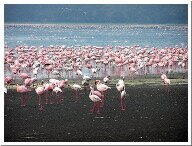 Nakuru125.jpg |
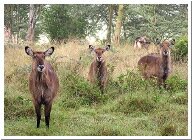 Nakuru80.jpg |
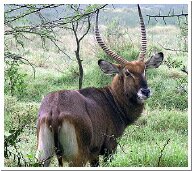 Nakuru81.jpg |
| Fallen feathers from the birds are collected and made into decorative flowers which are a popular tourist souvenir. | This trio of deer in the Lake Nakuru area seem just as curious and interestsed in a van full of tourists as the tourists are of them. | The waterbuck or antelope, with its large curved antlers, is seen in all of the game preserves. |
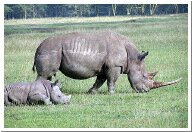 Nakuru109.jpg |
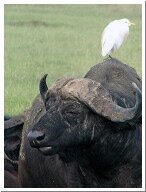 Nakuru121.jpg |
 Nakuru136.jpg |
| There are a number rhinos around Lake Nakuru. In this case its a white rhino with her baby. The rhino is one of the strangest looking animals in the world and can be one of the most dangerous as well if it charges. | This water buffalo doesn't seem at all concerned that he has a fellow traveler in the form of an egret. | Giraffes with their long necks are able to survive by eating the good vegetation at the top of trees and plants that are out of reach of other herbivores. |
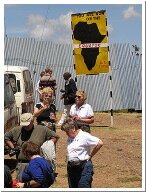 OnRoad107.jpg |
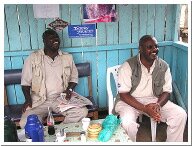 OnRoad06.jpg |
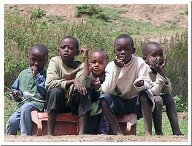 OnRoad222.jpg |
| The Equator runs through the middle of Kenya so if you do much traveling in the country you probably will cross the Equator several times. | Two of our Kenyan friends were Sammie, at left, our excellent driver and guide and Desmond, the tour director for Smartours. | Wherever our vans stopped for rest breaks there was always a group of children around to watch. This group was across from a popular stop where crafts are made. |
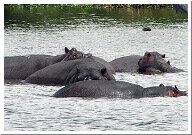 P1010241.jpg |
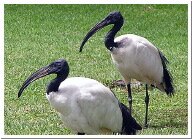 P1010281.jpg |
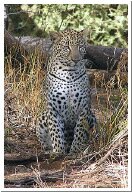 SamburuGame16.jpg |
| A regular sight at Lake Naivasha on a boat ride are many groups of hippos enjoying a lazy day in the water. | These strange looking birds are found along the shores of Lake Naivasha. | Of all the photos taken during the Kenya safari this is my most favorite. This beautiful and elegant leopard seemed to be enjoying posing for tourist cameras. |
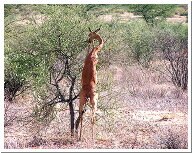 SamburuGame28.jpg |
 SamburuGame31.jpg |
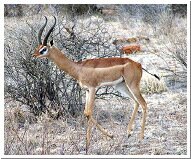 SamburuGame50.jpg |
| A gerunuk is a strange looking animal. It looks like a deer with anorexia. With its slim frame, long neck and long legs it is able to reach vegetation not available to many other animals. | You never know when you will run into an elephant. They are not always in herds on the savannah. This fellow just appeared from the forest to cross the road in front of our van. | The impala is another sleek member of the antelope family. With its long legs it can run fast. |
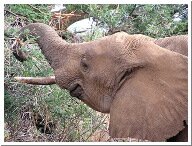 SamburuGame79.jpg |
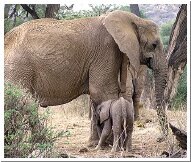 SamburuGame82.jpg |
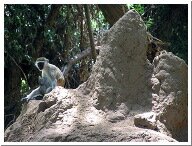 SamLodge30.jpg |
| Elephants can make short work of a tree when they are searching for lush vegetation. They have been known to knock down trees to get to their delectible tops. | Baby elephants don't stray far from their mothers. There are usually no adult males in the herd because they go off to a bachelor group after the cow gives birth . | A frequent sight in the Samburu area are large mounds of dirt which are termite nests. They make a good vantage point for monkeys to hang out and watch the tourists. |
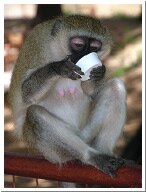 SamLodge51.jpg |
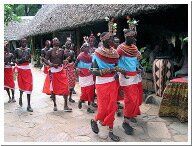 SamLodge56.jpg |
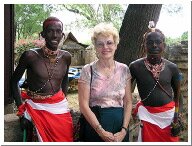 SamLodge59.jpg |
| Monkeys around hotels are notorious scavengers. This one has found a discarded container of some sort which still has something edible in it. | At the lodge, members of the Samburu tribe who live nearby come in each day to perform tribal dances for guests and answer questions about their lifestyle. | The Samburu, like the Masai, are a nomadic people who are herders and warriors. Clothing styles are different but they, too, like bright colors. |
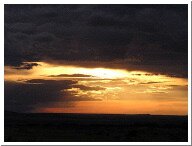 Sunset255.jpg |
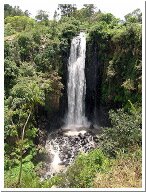 Thompson01.jpg |
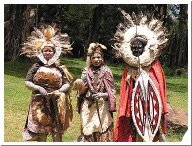 Thompson02.jpg |
| Because the land is flat late afternoon is a very special time. Sunsets are regularly as beautful and breathtaking as those anywhere in the world. | A regular tourist stop in Kenya is the Thompson Falls, named after a early explorer in the country. | Members of the Samburu tribe perform native chants and dances for tourists who visit Thompson Falls. |
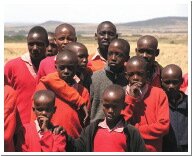 ToNairobi022.jpg |
 ToNairobi042.jpg |
|
| Leaving Masai Mara to go back to Nairobi requires a short flight from a dirt airstrip. On this particular day a bus load of students were on hand to watch the planes land and leave. | Entertaining tourists while they waited for the flight to Nairobi was this young man who also worked at a hotel nearby. |